Chinese people
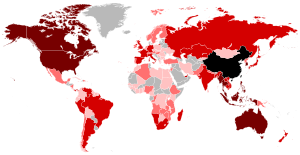
The Chinese people, or simply Chinese, are people or ethnic groups identified with China, usually through ethnicity, nationality, citizenship, or other affiliation.[1]
Chinese people are known as Zhongguoren (traditional Chinese: 中國人; simplified Chinese: 中国人) or as Huaren (traditional Chinese: 華人; simplified Chinese: 华人) by speakers of standard Chinese, including those living in Greater China as well as overseas Chinese. Although both terms both refer to Chinese people, their usage depends on the person and context. The former term is commonly (but not exclusively) used to refer to the citizens of the People's Republic of China—especially mainland China.[2][3][4][5] The term Huaren is used to refer to ethnic Chinese, and is more often used for those who reside overseas or are non-citizens of China.
The Han Chinese are the largest ethnic group in China, comprising approximately 92% of its Mainland population.[6] They comprise approximately 95% of the population of Taiwan,[7][8] 92% in Hong Kong,[9] and 89% in Macau.[10][11][better source needed] They are also the world's largest ethnic group, comprising approximately 18% of the global human population.[12][13]
Outside China, the terms "Han Chinese" and "Chinese" are often wrongly conflated since those identifying or registered as Han Chinese are the dominant ethnic group in China.[14][15] However, there are also 55 officially-recognized ethnic minorities in China who are also Chinese by nationality.
People from Taiwan, officially the Republic of China (ROC), may also be referred to as "Chinese" in various contexts, though they are usually referred to as "Taiwanese". The territory of Taiwan is disputed and the ROC has limited recognition of its sovereignty.
The term "Overseas Chinese" is used to refer to people of Chinese origin living overseas as well as Chinese citizens residing outside China, but more commonly the former.
Ethnic groups in China and associated territories

A number of ethnic groups as well as other racial minorities of China are referred to as Chinese people.[16]
Ethnic groups in China
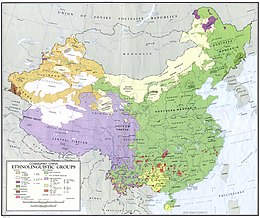
Han Chinese people, the largest ethnic group in China, are often wrongly referred to as "Chinese" or "ethnic Chinese" in English.[14][15][17] The Han Chinese also form a majority or notable minority in other countries, and they comprise approximately 18% of the global human population.[12][13]
Other ethnic groups in China include the Zhuang, Hui, Manchus, Uyghurs, and Miao, who make up the five largest ethnic minorities in mainland China, with populations of approximately 10 million or more. In addition, the Yi, Tujia, Tibetans and Mongols each have populations between five and ten million.
China, officially the People's Republic of China (PRC), recognizes 56 native Chinese ethnic groups. There are also several unrecognized ethnic groups in China.
Ethnic groups in dynastic China
The term "Chinese people" (Chinese: 中國之人; lit. 'People of China' Zhōngguó zhī rén; Manchu: Dulimbai gurun i niyalma) was used by the Qing government to refer to all traditionally native subjects of the empire, including Han, Manchu, and Mongols.[18]
Zhonghua minzu (the "Chinese nation")
Zhonghua minzu (simplified Chinese: 中华民族; traditional Chinese: 中華民族; pinyin: Zhōnghuá Mínzú), the "Chinese nation", is a supra-ethnic concept which includes all 56 ethnic groups living in China that are officially recognized by the government of the People's Republic of China. It includes established ethnic groups who have lived within the borders of premodern China.[19] The term zhonghua minzu was used during the Republic of China from 1911 to 1949 to refer to five primary ethnic groups[a] in China.[20] The term zhongguo renmin (Chinese: 中国人民), "Chinese people", was the government's preferred term during the early communist era; zhonghua minzu is more common in recent decades.[21]
Ethnic groups in Taiwan
This section needs additional citations for verification. (December 2021) |
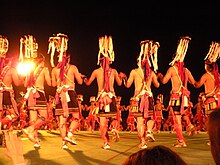
Taiwan, officially the Republic of China (ROC), recognizes 17 native Taiwanese ethnic groups as well as numerous other "New Immigrant" ethnic groups (mostly originating from mainland China and Southeast Asia). Of the 17 native Taiwanese ethnic groups, 16 are considered to be indigenous (Taiwanese indigenous peoples),[22] whereas one is considered to be non-native (Han Taiwanese).[23] There are also several unrecognized indigenous ethnic groups in Taiwan.
The Han Taiwanese, who are Han Chinese people living in Taiwan, are usually categorized by the Taiwanese government into three main ethnic groups; the Taiwanese Hoklos, Taiwanese Hakkas, and waishengren (i.e. "Mainland Chinese people in Taiwan"). The Kinmenese and Matsunese peoples are two other significant Han Taiwanese ethnic groups.
The Taiwanese Hoklos and Hakkas are both considered to be "native" populations of Taiwan since they first began migrating to Taiwan in significant numbers from Fujian and Guangdong over 400 years ago (they first began migrating to Taiwan in minor numbers several centuries earlier). They are often collectively referred to in Taiwanese Mandarin as "Benshengren" (meaning "people from this province"). Those self-identifying as Hoklo culturally comprise approximately 70% of Taiwan's total population and the Hakkas comprise approximately 14% of Taiwan's total population.
Meanwhile, the so-called Mainlanders (Taiwanese) are mostly descended from people who migrated from mainland China to Taiwan during the 1940s and 1950s. They are often referred to in Taiwanese Mandarin as "Waishengren" (meaning "people from outside of this province"). The Mainlanders (Taiwanese) comprise approximately 14% of Taiwan's total population.
Collectively, the various Taiwanese indigenous peoples comprise approximately 2% of Taiwan's total population. The various Taiwanese indigenous peoples are believed to have been living in Taiwan for up to 6000 years prior to the colonization of Taiwan by China which began during the 17th century (CE).
Recognition by the Chinese government
The Han Taiwanese, Native Taiwanese (Benshengren), Hoklo Taiwanese, Hakka Taiwanese, Mainlander Taiwanese (Waishengren), Kinmenese, and Matsunese ethnic groups (all subtypes or branches of the Han Chinese ethnic group) are all unrecognized by the Chinese government. Furthermore, the sixteen Taiwanese indigenous peoples that are officially recognized by the Taiwanese government are also all unrecognized by the Chinese government. The Chinese government also doesn't recognize the ethnic designation "New Immigrant".
The Chinese government instead has its own ethnic designations for Taiwanese people. Han Taiwanese people are considered to be Han Chinese people (no distinction is made), whereas the various recognized and unrecognized (by Taiwan) Taiwanese indigenous peoples are collectively recognized (by China) to be "Gaoshanren" (i.e. "High Mountain People"). The Gaoshanren are one of the 56 officially-recognized ethnic groups of China.
Nationality, citizenship and residence
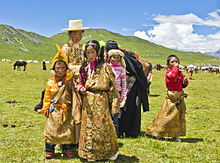
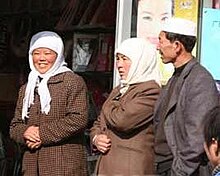
The Nationality law of the People's Republic of China regulates nationality within the PRC. A person obtains nationality either by birth when at least one parent is of Chinese nationality or by naturalization. All people holding nationality of the People's Republic of China are citizens of the Republic.[24] The Resident Identity Card is the official form of identification for residents of the People's Republic of China.
Within the People's Republic of China, a Hong Kong Special Administrative Region passport or Macao Special Administrative Region passport may be issued to permanent residents of Hong Kong or Macao, respectively.
The Nationality law of the Republic of China regulates nationality within the Republic of China (Taiwan). A person obtains nationality either by birth or by naturalization. A person with at least one parent who is a national of the Republic of China, or born in the ROC to stateless parents qualifies for nationality by birth.[25]
The National Identification Card is an identity document issued to people who have household registration in Taiwan. The Resident Certificate is an identification card issued to residents of the Republic of China who do not hold a National Identification Card.
The relationship between ROC nationality and PRC nationality is disputed.[26]
Overseas Chinese
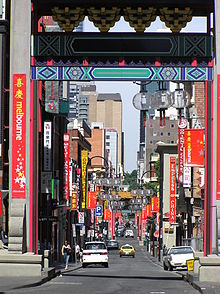
Overseas Chinese refers to people of Chinese ethnicity or national heritage who live outside the People's Republic of China or Taiwan as the result of the continuing diaspora.[31] People with one or more Chinese ancestors may consider themselves overseas Chinese.[32] Such people vary widely in terms of cultural assimilation. In some areas throughout the world ethnic enclaves known as Chinatowns are home to populations of overseas Chinese.
In Southeast Asia, people of Chinese descent call themselves 華人 (Huárén) instead of (中國人 Zhōngguórén) which commonly refers to the citizens of the People's Republic of China or the Republic of China.[33] This is especially so in the Chinese communities of Southeast Asia. The term Zhongguoren has a more political or ideological aspect in its use; while many in China may use Zhongguoren to mean the Chinese ethnicity, some in Taiwan would refuse to be called Zhongguoren.[5]
See also
- For countries with significant populations
- For countries with noteworthy populations
- Other countries with Chinese populations
- Chinese American
- Chinese Argentine
- Chinese Brazilian
- British Chinese
- Chinese Burmese
- Chinese Cambodian
- Chinese Caribbean
- Chinese Cuban
- Chinese Dominican
- Chinese Guyanese
- Chinese Indonesian
- Chinese Italian
- Chinese Jamaican
- Chinese Korean
- Chinese Laotian
- Chinese Mexican
- Chinese Peruvian
- Chinese Puerto Rican
- Chinese Russian
- Chinese Surinamese
- Chinese Trinidadian and Tobagonian
- Chinese Venezuelan
- Chinese Vietnamese
- Related topics of interest
References
- ^ Harding, Harry (1993). "The Concept of "greater China": Themes, Variations and Reservations". The China Quarterly. 136 (136): 660–86. doi:10.1017/S030574100003229X. JSTOR 655587. S2CID 154522700.
- ^ https://www.zdic.net/hans/%E4%B8%AD%E5%9B%BD%E4%BA%BA Archived 27 March 2022 at the Wayback Machine 生息、繁衍,居住在中国的本地人或者海外有中国血统的侨胞 Local people who live, reproduce, reside in China, or Chinese nationals of Chinese descent living overseas.
- ^ https://cwn.ling.sinica.edu.tw/_process.asp?inputword=%A4%A4%B0%EA%A4H&radiobutton=1 Archived 1 October 2022 at the Wayback Machine 普通名詞。中華民族的族人或中國大陸的人民。 noun, ethnic groups of Zhonghua Minzu, or people of China
- ^ Pan, Lynn, ed. (April 1999). "Huaqiao". The Encyclopedia of the Chinese Overseas. Harvard University Press. ISBN 0674252101. LCCN 98035466. Archived from the original on 17 March 2009. Retrieved 17 March 2009.
- ^ a b Hui-Ching Chang; Richard Holt (20 November 2014). Language, Politics and Identity in Taiwan: Naming China. Routledge. pp. 162–64. ISBN 978-1-135-04635-4. Archived from the original on 30 September 2023. Retrieved 13 October 2018.
- ^ CIA Factbook Archived 13 February 2021 at the Wayback Machine: "Han Chinese 91.6%" out of a reported population of 1,379 billion (July 2017 est.)
- ^ 中華民國國情簡介 [ROC Vital Information]. Executive Yuan (in Chinese (Taiwan)). 2016. Archived from the original on 18 February 2017. Retrieved 23 August 2016.
臺灣住民以漢人為最大族群,約占總人口97%
- ^ Executive Yuan, R.O.C. (2014). The Republic of China Yearbook 2014 (PDF). Government Information Office. p. 36. ISBN 978-986-04-2302-0. Archived (PDF) from the original on 20 August 2017. Retrieved 11 June 2016.
- ^ 2016 Population By-census – Summary Results (Report). Census and Statistics Department. February 2016. p. 37. Archived from the original on 20 November 2017. Retrieved 14 March 2017.
- ^ 2016 Population By-Census Detailed Results (Report). Statistics and Census Service. May 2017. Archived from the original on 8 April 2020. Retrieved 25 July 2019.
- ^ Population By-Census 2016, p. 47.
- ^ a b Zhang, Feng; Su, Bing; Zhang, Ya-ping; Jin, Li (22 February 2007). "Genetic Studies of Human Diversity in East Asia". Philosophical Transactions of the Royal Society B: Biological Sciences. 362 (1482): 987–996. doi:10.1098/rstb.2007.2028. PMC 2435565. PMID 17317646.
- ^ a b Zhao, Yong-Bin; Zhang, Ye; Zhang, Quan-Chao; Li, Hong-Jie; Cui, Ying-Qiu; Xu, Zhi; Jin, Li; Zhou, Hui; Zhu, Hong (2015). "Ancient DNA Reveals That the Genetic Structure of the Northern Han Chinese Was Shaped Prior to three-thousand Years Ago". PLOS One. 10 (5): e0125676. Bibcode:2015PLoSO..1025676Z. doi:10.1371/journal.pone.0125676. PMC 4418768. PMID 25938511.
- ^ a b Who are the Chinese people? Archived 6 September 2021 at the Wayback Machine (in Chinese). Huayuqiao.org. Retrieved on 26 April 2013.
- ^ a b "Han". Merriam-Webster's Collegiate Dictionary (Tenth ed.). Merriam-Webster. 1993.
- ^ "Chinese". Merriam-Webster's Collegiate Dictionary (Tenth ed.). Merriam-Webster. 1993.
- ^ Yang, Miaoyan (2017). Learning to Be Tibetan: The Construction of Ethnic Identity at Minzu. Lexington Books (published 17 March 2017). p. 7. ISBN 978-1498544634.
- ^ Zhao, Gang (2006). "Reinventing China: Imperial Qing ideology and the rise of Modern Chinese national identity in the early twentieth century" (PDF). Modern China. 32 (3). Sage: 3–30. doi:10.1177/0097700405282349. S2CID 144587815. Archived from the original on 25 March 2014. Retrieved 29 May 2016.
{{cite journal}}: CS1 maint: unfit URL (link) - ^ "Brief Introduction Chinese nationality". Chinatraveldepot.com. Archived from the original on 1 July 2017. Retrieved 23 July 2014.
- ^ Millward, James A. (2007). Eurasian Crossroads: A History of Xinjiang. Columbia University Press. ISBN 978-0-231-13924-3.
- ^ Jenner, W.J.F. (2004). "Race and history in China". In Alan Lawrance (ed.). China Since 1919: Revolution and Reform: a Sourcebook. Psychology Press. pp. 252–255. ISBN 978-0-415-25141-9. Archived from the original on 17 January 2023. Retrieved 19 October 2015.
- ^ Copper, John F. (2014). Historical Dictionary of Taiwan (Republic of China). Rowman & Littlefield. p. 53. ISBN 978-1-4422-4307-1.
- ^ "About Taiwan". Taiwan (official website). Archived from the original on 17 November 2021. Retrieved 5 December 2019.
- ^ "Constitution of the People's Republic of China (Article 33)". People's Daily Online. 2 May 1982. Archived from the original on 12 August 2010. Retrieved 23 July 2014.
- ^ "Nationality Act". Laws & Regulations Database of the Republic of China. 27 January 2006. Archived from the original on 21 January 2016. Retrieved 23 July 2014.
- ^ "Nationality Act". National Immigration Agency, immigration.gov.tw. Archived from the original on 27 September 2007.
- ^ "Chinatown Melbourne". Archived from the original on 25 January 2014. Retrieved 23 January 2014.
- ^ "Melbourne's multicultural history". City of Melbourne. Archived from the original on 30 September 2023. Retrieved 23 January 2014.
- ^ "World's 8 most colourful Chinatowns". Archived from the original on 31 January 2014. Retrieved 23 January 2014.
- ^ "The essential guide to Chinatown". Melbourne Food and Wine Festival. Food + Drink Victoria. 3 February 2021. Archived from the original on 14 February 2022. Retrieved 11 February 2022.
- ^ Barabantseva, Elena (2010). Overseas Chinese, Ethnic Minorities and Nationalism: De-Centering China. Routledge. ISBN 978-1-136-92736-2.
- ^ Park, Yoon Jung (2008). A Matter of Honour: Being Chinese in South Africa. Lexington Books. p. 155. ISBN 978-0-7391-3553-2.
- ^ Beeson, Mark (2008). Contemporary Southeast Asia. Palgrave Macmillan. p. 118. ISBN 978-1-137-06880-4.
External links
- Chinese Ethnic Minorities
- The Ranking of Ethnic Chinese Population, Overseas Compatriot Affairs Commission, Republic of China, archived from the original on 23 November 2013, retrieved 2 November 2008
